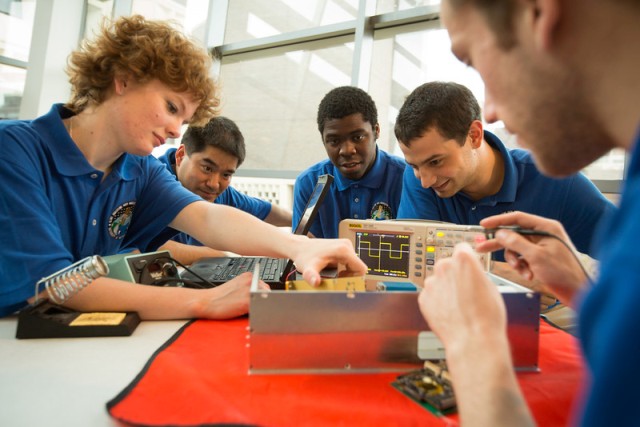Feb 11 2016
Too bad there is no frequent flier program for microsatellites. If there was, University at Buffalo students would accrue serious points.
 UB students at work building the microsatellite GLADOS, which is scheduled to be launched into outer space next year. Credit: Douglas Levere, University at Buffalo.
UB students at work building the microsatellite GLADOS, which is scheduled to be launched into outer space next year. Credit: Douglas Levere, University at Buffalo.
For the third time in the past four years, they have been selected by federal agencies to design and build a microsatellite destined for outer space.
The latest satellite, called Spectrometry Observation for Reflectivity Analysis (SORA), will help identify what the thousands of pieces of debris orbiting Earth are made of. Researchers aim to use that information to ensure that debris, also known as space junk, does not crash into other spacecraft.
“To be selected to build another satellite really shows just how dedicated and talented our students are,” said John Crassidis, PhD, CUBRC Professor in Space Situational Awareness in UB’s School of Engineering and Applied Sciences, who oversees the satellite projects. “They are gaining valuable hands-on experience and helping solve a very serious problem that threatens existing and future space missions.”
NASA estimates more than 20,000 pieces of debris larger than a softball are orbiting Earth at speeds up to 17,500 mph. It is unlikely those objects will enter Earth’s atmosphere, but the odds that one will strike and damage functioning satellites and other spacecraft are increasing, according to the National Research Council.
Because there is no cost-effective way to remove debris, researchers want to better track objects to avoid potential collisions.
The Air Force Research Laboratory (AFRL) asked UB in 2013 to design and build a microsatellite that tracks space debris in high-Earth orbit, a field more than 22,000 miles from Earth’s surface that contains weather and telecommunication satellites. The satellite, dubbed GLADOS (short for Glint Analyzing Data Observation Satellite), is scheduled for launch next year.
The project impressed NASA, which in 2014 requested a similar satellite, also named GLADOS. That satellite is set for a 2018 launch.
The third satellite, approved in December by the Utah State University Research Foundation, which administers AFRL’s University Nanosatellite Program, will differ slightly from the other two. Instead of tracking debris, it will characterize what the debris is made of.
For example, it could identify an object as gallium arsenide, a chemical compound common in solar cells. Knowing the chemical composition of debris will enable researchers to estimate where it came from (in this case, its likely part of a solar panel that separated from a satellite) and where it’s going (chemicals behave certain ways in space, thereby making it easier to predict the path debris will travel).
Up to 100 students will work on the new satellite, which Crassidis expects the Air Force to launch within two to four years.
Source: http://www.buffalo.edu/